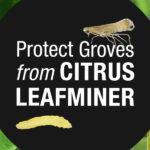Ag Avengers Combat Corn Rootworm
NK Seeds and Pearl City Elevator team up to fight corn rootworm.

The northwest corner of Illinois has some of the highest corn rootworm (CRW) pressure in the state. That puts Steve Marr, sales agronomist at Pearl City Elevator, Inc., in Warren, at ground zero in the fight to protect yields from what’s known as “the billion-dollar pest.”
“That’s not an exaggeration by any means,” Marr says of the moniker. “Last year, corn rootworm definitely took a toll on the crops. So this year, it’s a point of emphasis for growers who are trying to decide how to best control it and mitigate their losses.”
Joining Marr and area growers in that effort is Susie Heavner, sales representative for NK Seeds. While still in college, Heavner signed on as an intern with Syngenta. After graduation, she started as a developmental sales representative and then took a sales rep role, where she now serves northwestern Illinois.
“One thing I knew I wanted to provide as a service was working with retailers to help their growers better manage corn rootworm,” she says.
Since then, Heavner and Marr have been spreading the word about NK® corn and traits, including Agrisure Duracade® trait stacks. These trait stacks offer a unique protein and multiple modes of action that make them the foundation of any CRW management program. Managing below-ground pests also pays off above-ground with healthier plants, fuller leaves that allow for increased photosynthesis and maximum grain fill, and more robust stalks that stand tall.
“Nothing’s going to be a silver bullet for any kind of pest,” Heavner says. “But what I’m trying to provide to Steve is another tool in his toolbox that he can use to help his growers avoid the high cost corn rootworm can impose on their crops.”
Any growers concerned about CRW should have a multiyear management plan in place that incorporates multiple control strategies for each field, including crop rotation, CRW-traited corn hybrids, soil-applied insecticides and adult beetle management. The Syngenta “Take Control of Corn Rootworm” decision guide, available from any Syngenta representative, can help growers build an effective management plan.
Last year, corn rootworm definitely took a toll on the crops. So this year, it’s a point of emphasis for growers who are trying to decide how to best control it and mitigate their losses.
Crops and Cows
For Marr and many of his growers, there’s another benefit to his partnership with Heavner: A number of his customers are dairy producers interested in dual-purpose silage and grain hybrids to be used as feed for their dairy herds, and Enogen® corn for feed — available through NK retailers — fits the bill.
“I’ve had conversations about the benefits of Enogen corn hybrids with the Agrisure Duracade trait and the potential benefits it can have from a feed standpoint,” Marr says. “It garners interest from growers pretty quickly.”
Third-generation farmer Tim Leitzinger is one of those growers. He raises corn and alfalfa, along with 150 dairy cows and a small beef herd, on 500 acres in Lafayette County, Wisconsin.
“Rootworm has been a significant problem in our corn-on-corn acres over the last several years,” he says. “Steve brought Susie to talk with us when we originally started considering Enogen corn for our silage needs, and they provided information and data that led us to believe Enogen corn hybrids with the Agrisure Duracade trait were worth planting.”
Leitzinger had tried other traited corn hybrids but was interested in the ability of Enogen with Agrisure Duracade to protect the plant from CRW feeding as well as its potential benefits to the farm’s silage. Enogen corn silage maximizes starch digestibility, and research shows an increase in sugar content even while silage is in the pit. The result can be an increase in feed efficiency of about 5%,1 which helps cattle producers reduce feed costs and improve profit potential for their operations.
“We don’t operate extra acres, so we need to be aggressive with the acres we do have,” Leitzinger says. “Spending responsibly to maximize our own acres is definitely better than having to buy forages.”
Another aspect of the Enogen trait that’s intriguing to growers, Marr says, is that, unlike some other silage-specific hybrids, Enogen corn hybrids don’t have to be managed differently than traditional corn hybrids.2 And since Enogen hybrids are offered in elite genetics, producers can take advantage of their feed efficiency benefits without sacrificing yield.
“Some feed hybrids on the market do require special treatment due to the genetics,” he says. “They inherently don’t handle stress as well; they don’t have good disease tolerance; and the roots and stalks may not be as strong. Enogen just offers more peace of mind to growers.”
In-Person Service During a Pandemic
Providing service during a pandemic presented a challenge, but Heavner found a creative opportunity in the crisis. She largely replaced field days with Tailgate Talks, smaller gatherings where attendees could socially distance by sitting on their own tailgates. The format has advantages.
“If you have a presenter talking and there are 50 people around you, the likelihood of raising your hand to ask a question is a lot lower than when you’re in a group of 10 people,” Heavner says. “So, I think Tailgate Talks may have been more effective because we had more interactive discussion.”
Heavner and Marr both prefer face-to-face meetings, but Zoom eventually came into play when it was time to report to retailers on the harvest and product performance.
“I would have liked to have done that in person; but if I had waited to meet in person in big groups, I would have been late to the game from a sales and a resource perspective,” Heavner says.
Everyone hopes that the 2021 season will be a return to normalcy. But no matter what’s going on globally, Pearl City Elevator customers know their level of service will stay high.
“Steve understands that we need to maximize our production while also keeping expenses reasonable and manageable,” Leitzinger says. “He brings us information and recommendations that give us a good return on investment and meet our production needs.”
1 University of Nebraska-Lincoln Research Studies, 2013–2017; Kansas State University Research Studies, 2016–2018; Penn State University Research Study, 2020.
2 Growers must comply with specific yet simple stewardship requirements.
4 Min Read























